Colorado State Patrol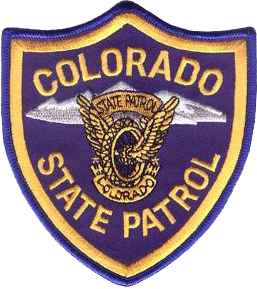
Colorado State Patrol
The Colorado State Patrol was established in 1935 as a division of the Colorado Department of Highways. The agency was originally known as the Colorado State Highway Courtesy Patrol. It was one of only four law enforcement agencies then existing in the state of Colorado.
On September 23, 1935, 44 men were the first to wear the uniform of the Courtesy Patrol as the original pioneer members to the future Colorado State Patrol. By 1945, the ranks of the Courtesy Patrol had grown to 100 Patrolmen, 10 Sergeants, 6 Captains, 1 Assistant Chief and the Chief.
In 1947, the organization's name was formally changed to the Colorado State Patrol. The original Patrol Act specified that "it shall be their duty to promote safety, protect human life and preserve the highways of Colorado by the intelligent, courteous, and strict enforcement of the laws and regulation of this state relating to highways." Courtesy thus became the underlying theme of the Patrol Act.
In 1955, when the Colorado State Patrol began issuing its own distinct license plates for CSP vehicles, the agency was up to 200 patrolmen, 12 Corporals, 13 Sergeants, 10 Captains, a Deputy Chief and a Chief. By 1956, the Colorado State Patrol had 156 cars (mostly Ford Interceptors) and 20 motorcycles being used for highway patrol.
1965 saw one hundred and twenty three new Plymouth Furys arrive for patrol on Colorado's highways and by-ways.
In 1984, the CSP moved from the Department of Highways to the Department of Public Safety.
Prior to the State Patrol getting its own titled license plates in 1950, all CSP patrol vehicles from 1937 to 1949 used regular passenger license plates issued from the local county issuing offices where CSP units were assigned. A CSP unit assigned out of Arapahoe County (County 10) would have a standard County 10 passenger license plate issued to it where the last 1, 2 or 3 digits would be the actual car number. Examples of these assignments are seen below.
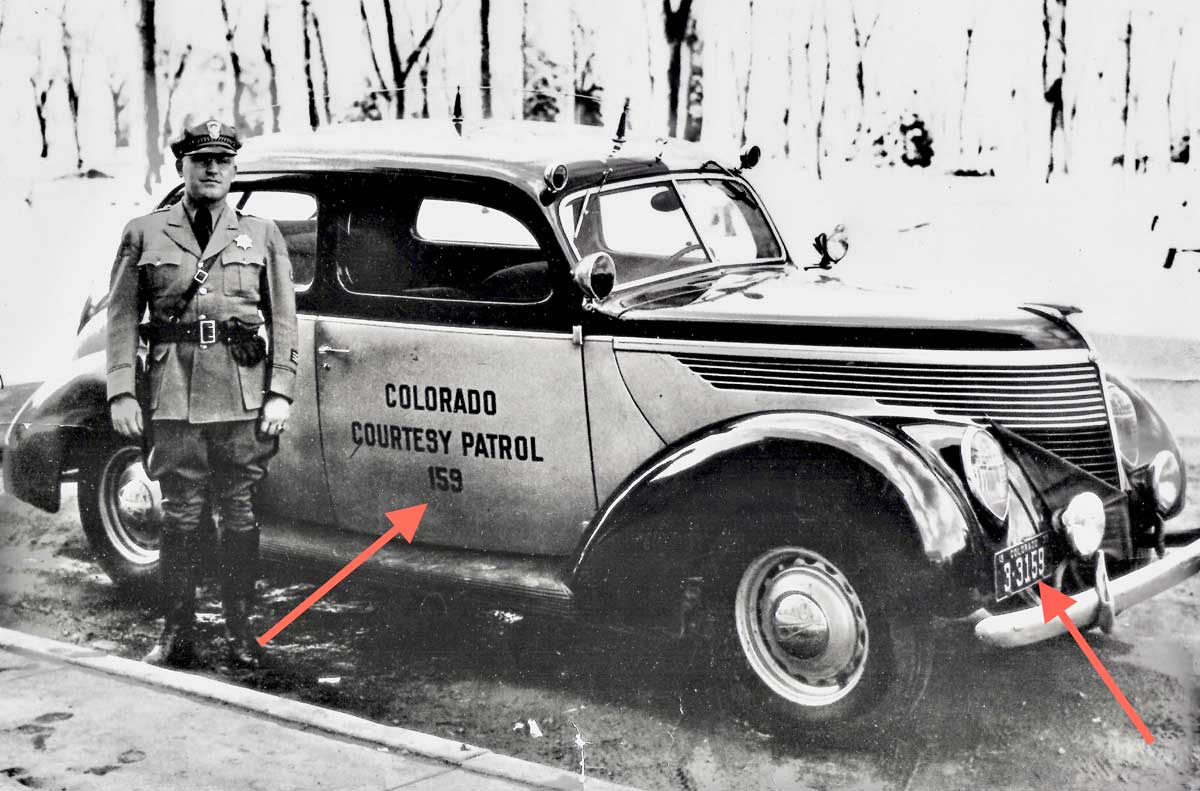 1939- Car 159 running County 3 (Weld County) passenger license plate 3- 3159.
1939- Car 159 running County 3 (Weld County) passenger license plate 3- 3159.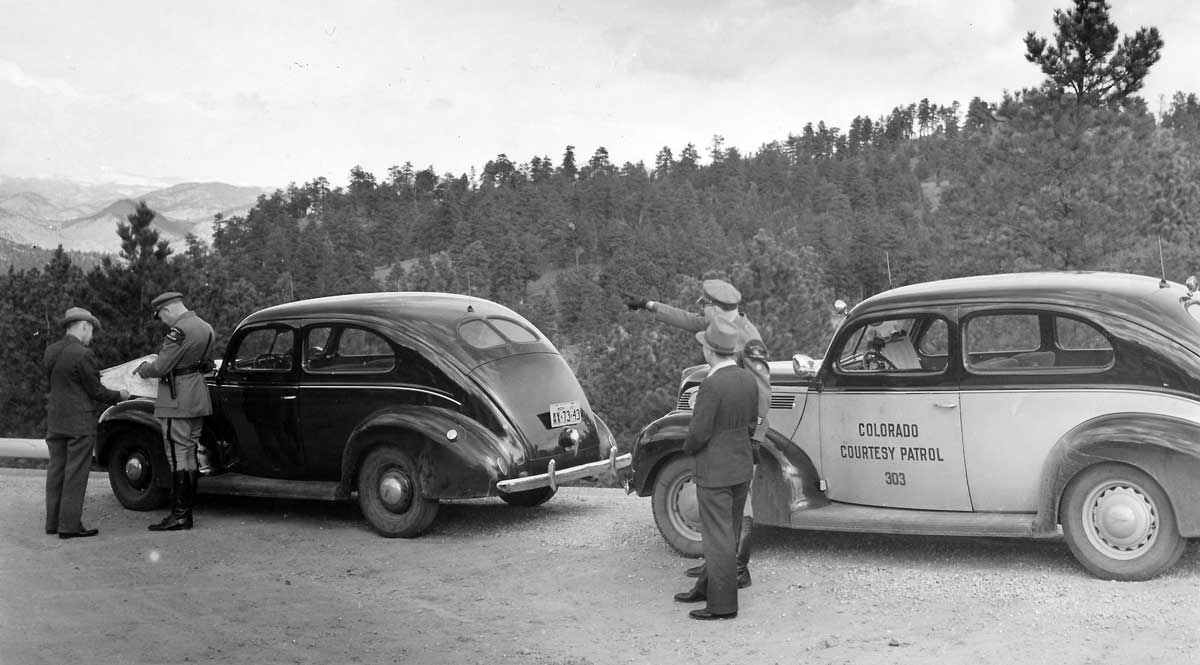 (Courtesy Bruce Davisson)
(Courtesy Bruce Davisson)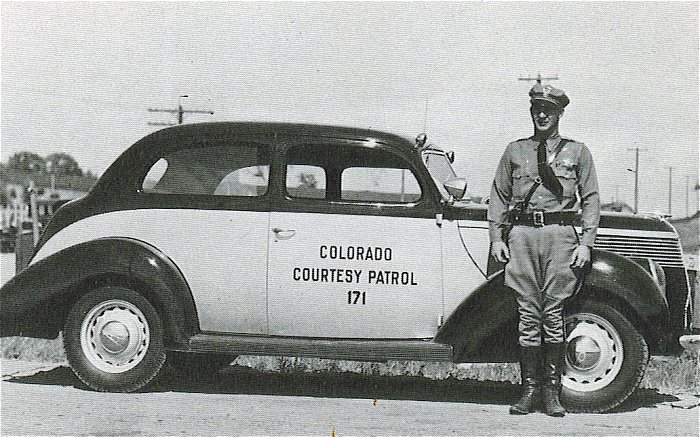 1938 Colorado Courtesy Patrol
1938 Colorado Courtesy Patrol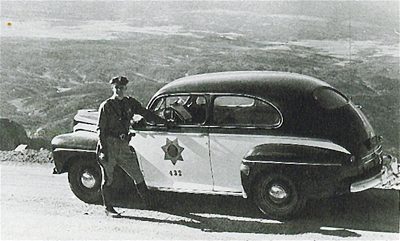 1945 CSP Ford
1945 CSP Ford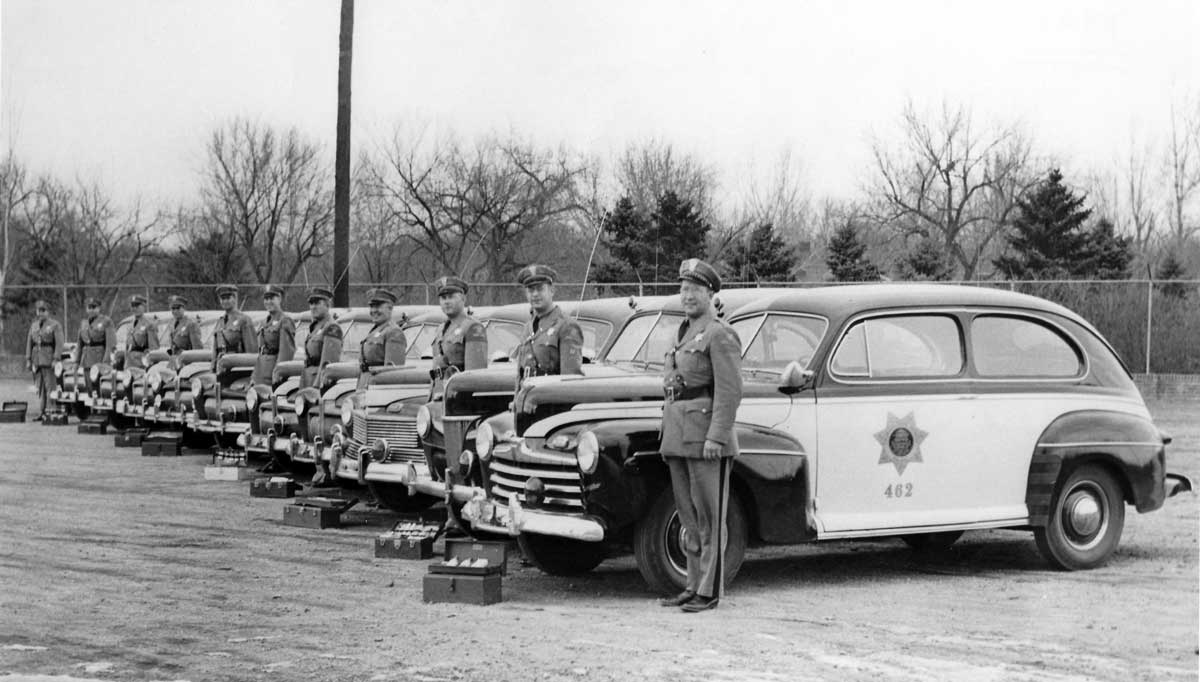 Inspection- 1948.
Inspection- 1948.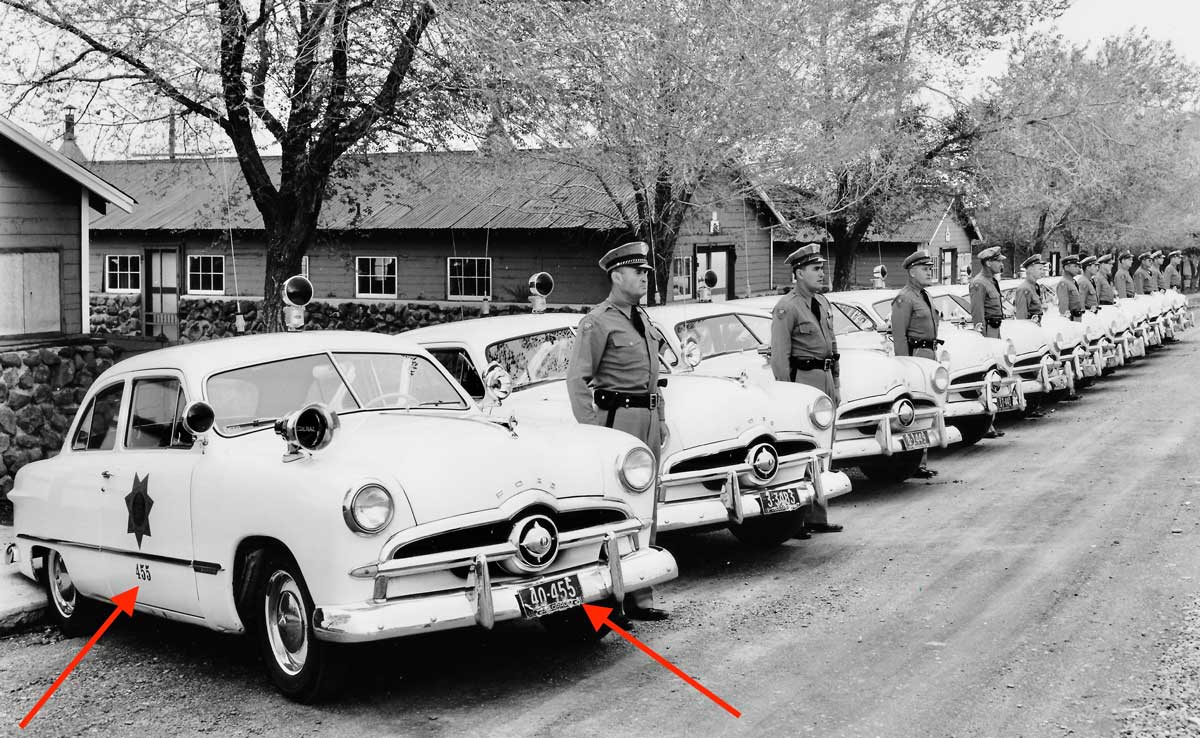 1949- Car 455 running County 40 (Gunnison County) passenger license plate 40-455.(Courtesy Bruce Davisson)
1949- Car 455 running County 40 (Gunnison County) passenger license plate 40-455.(Courtesy Bruce Davisson)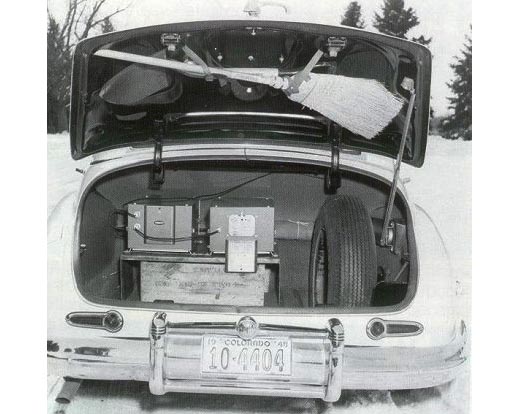
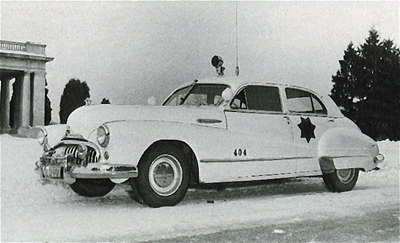 1948- shows a marked CSP
Buick number 404.
1948- shows a marked CSP
Buick number 404. In 1950, a black over white embossed steel license plate measuring 6" x 13 3/4" was produced, however the only specimens ever seen were samples bearing the number 000. The format was STATE PATROL over 000 over COLORADO and consisted of four short-slotted mounting holes.
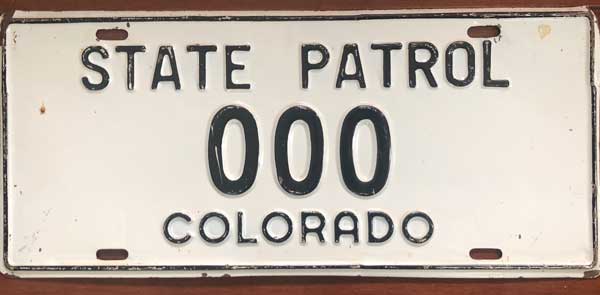 1950-c.1954 First issue.
1950-c.1954 First issue. 
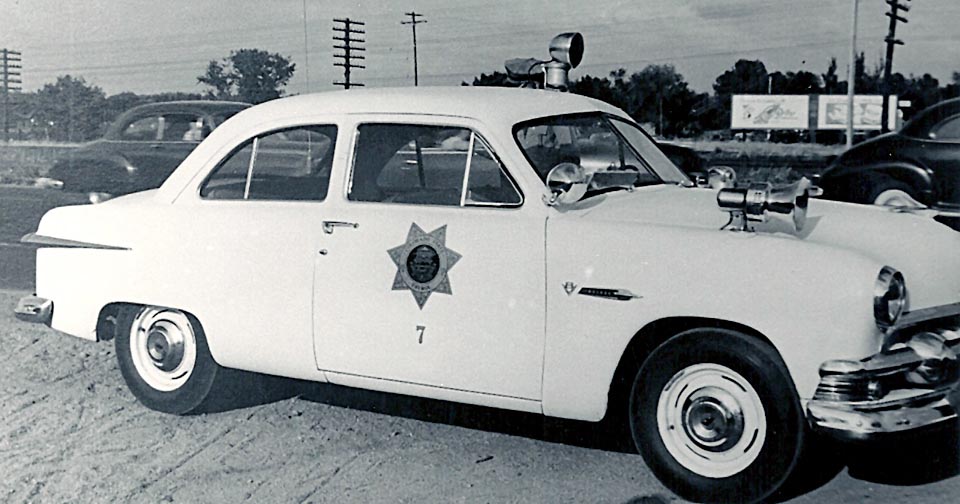
From 1955 to 1970, a similarly-formatted plate was issued however it measured 6" X 12" and was made of very heavy gauge steel. Some people mistake these plates for porcelain enamel due to their durable construction. Black over flat white. STATE PATROL over a number up to 3 digits over COLORADO and consisted of four medium-sized rectangular mounting slots. This issue was known as the "Bulletproof Issue" due to its solid and heavy gauge steel. Each single plate weighs over 1 pound. One CSP retiree quipped to me that when he totaled his patrol car back in the late 1960's, although the car was a total write-off, the plates withstood the impact well enough that they were able to be used again!
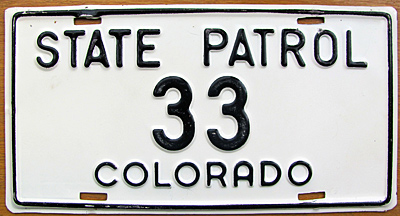 1955-1970 issue-
1955-1970 issue- 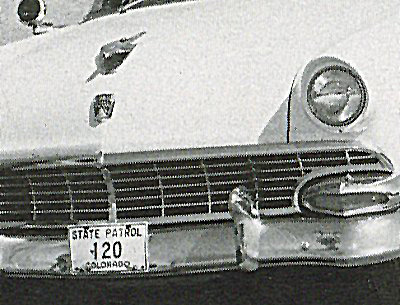
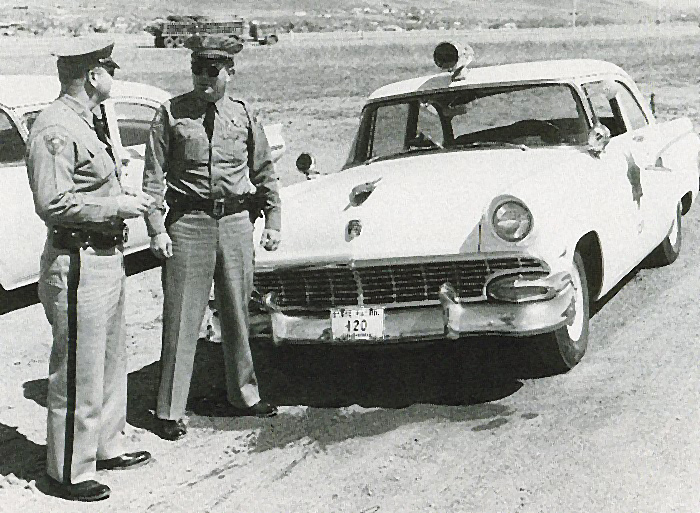
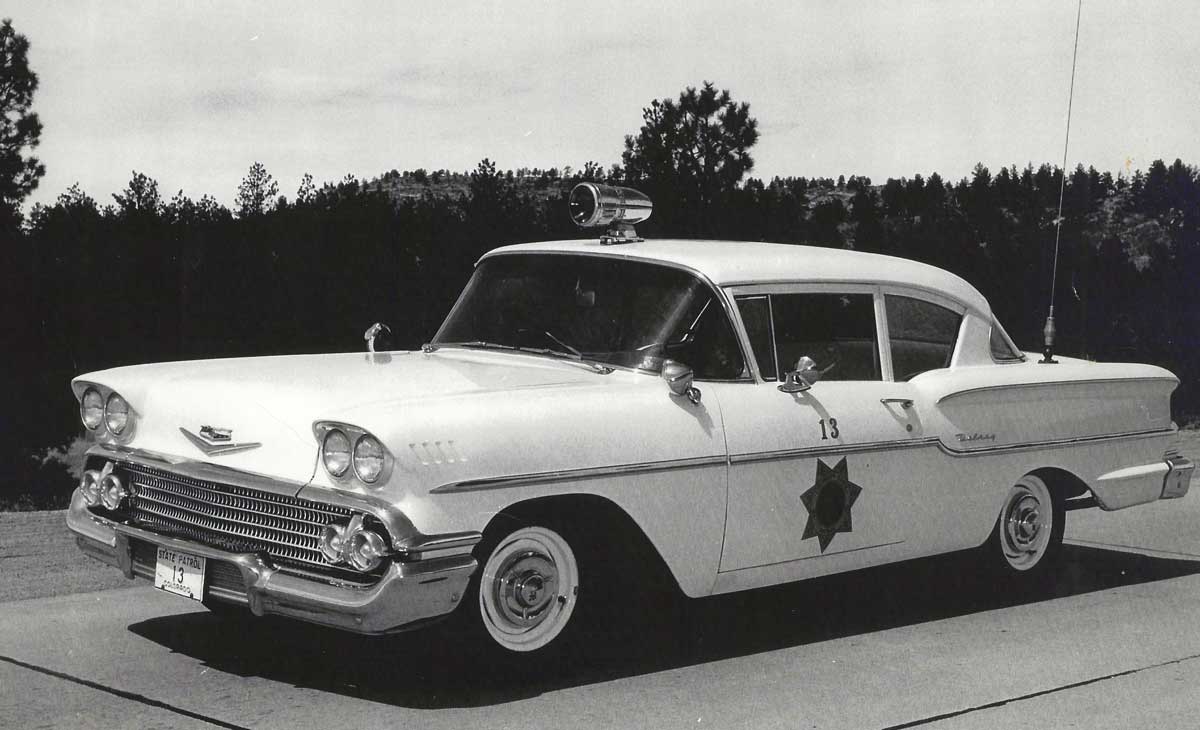 1958 CSP Chevrolet # 13
1958 CSP Chevrolet # 13 1961 CSP Plymouth # 53
1961 CSP Plymouth # 53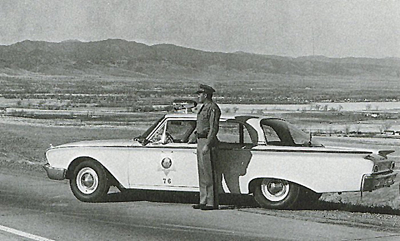 1960 CSP Ford # 76
1960 CSP Ford # 76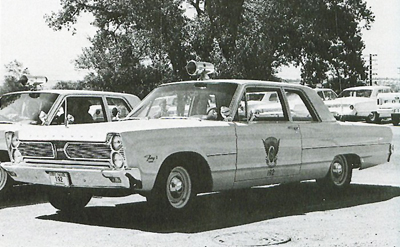 1967 CSP Plymouth Fury # 192
1967 CSP Plymouth Fury # 192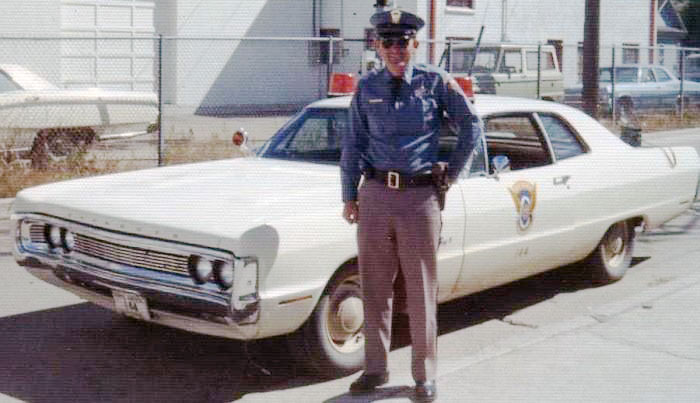 Number 144 Circa 1970.
Number 144 Circa 1970. 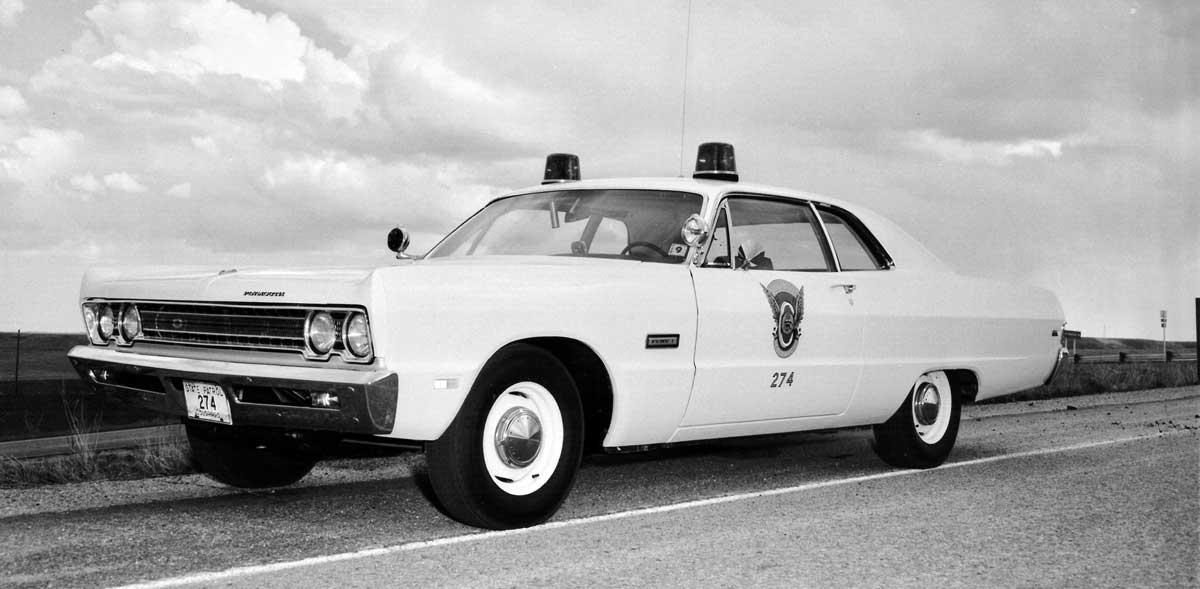 1969 CSP Plymouth #274
1969 CSP Plymouth #274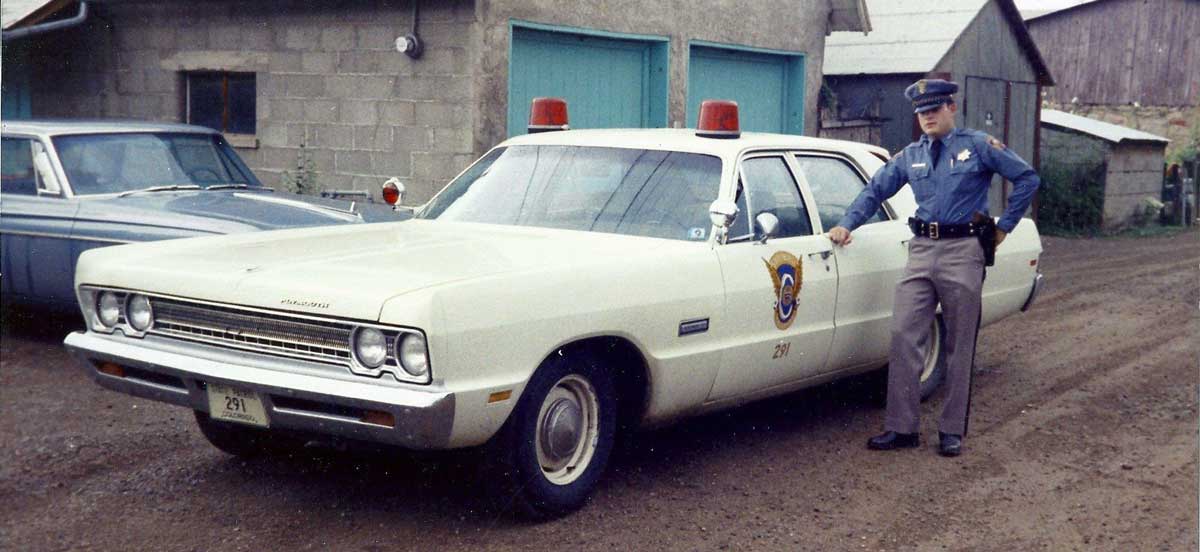 1969 CSP Plymouth #291
1969 CSP Plymouth #291From 1970 to 1983, a much lighter embossed steel version of the same plate was used. Black over reflective white. STATE PATROL over a number up to three digits over COLORADO.
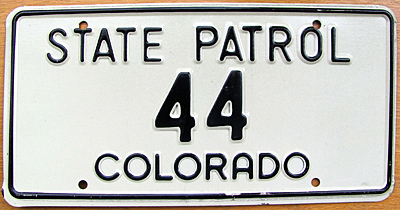 1970-1983 issue- Embossed steel.
1970-1983 issue- Embossed steel. 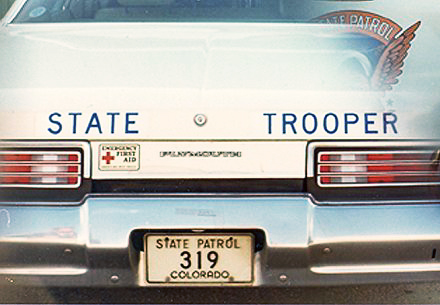 1976 CSP Plymouth Gran Fury
1976 CSP Plymouth Gran Fury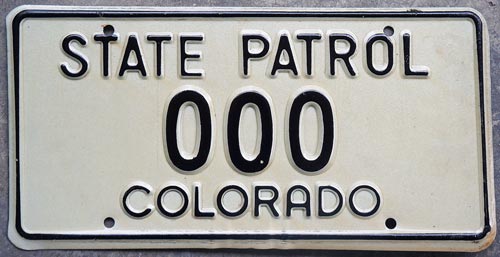 1970-1983 SAMPLE issue.
1970-1983 SAMPLE issue. 
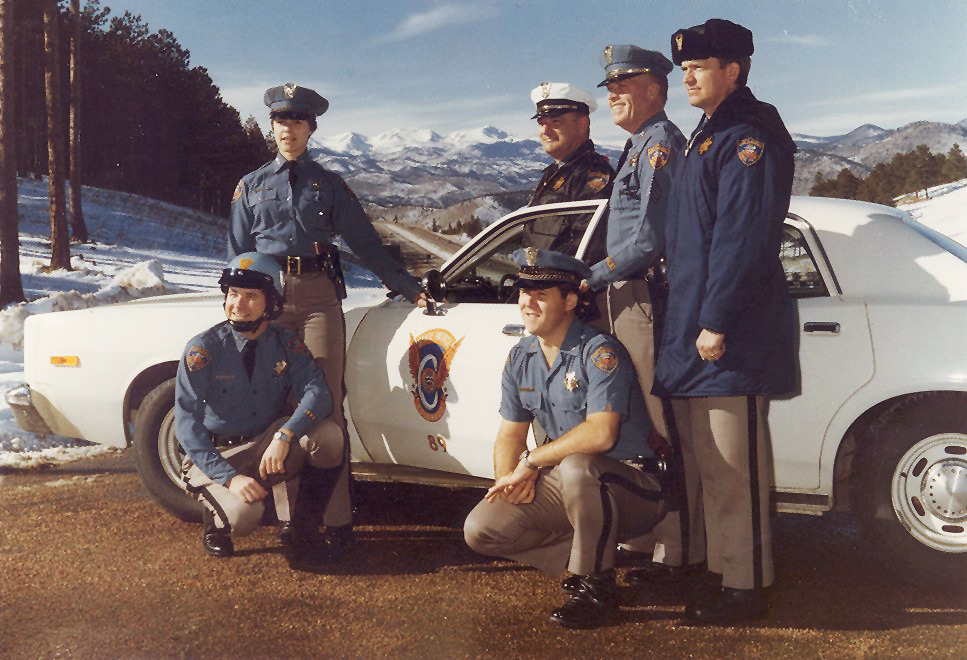
In 1982, an embossed galvanized steel version of the same plate was issued but with STATE PATROL in smaller font over >a number up to three digits over COLORADO. This was used for only one year and used concurrent with the 1970 base plate.
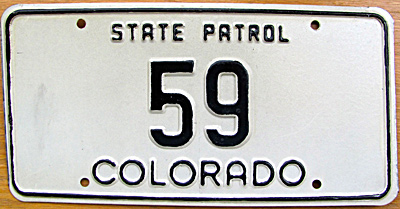 1982 issue- Embossed galvanized steel.
1982 issue- Embossed galvanized steel. 
 1982 SAMPLE issue.
1982 SAMPLE issue. 
1983 to 1989 saw the use of "Auditor Code" plates. There were three distinct varieties during these six years. The first version is embossed galvanized steel. Green over reflective white. STATE PATROL embossed in small font over a number beginning with 10 followed by a dash and 4 numbers over COLORADO. The number 10 prefix was the numerical designation for the Colorado Department of Highways, of which the state patrol was under at the time. Issued in Spring of 1983. These plates were never popular with CSP troopers. (See plate #10-0140)
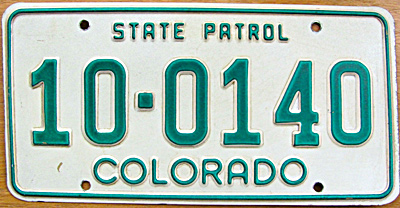 1983-1989 first issue.
1983-1989 first issue. 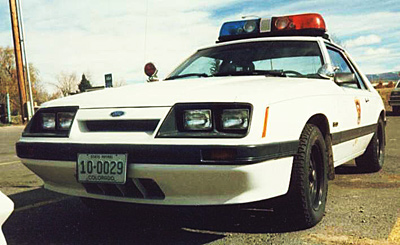 CSP SSP Mustang Number 29
CSP SSP Mustang Number 29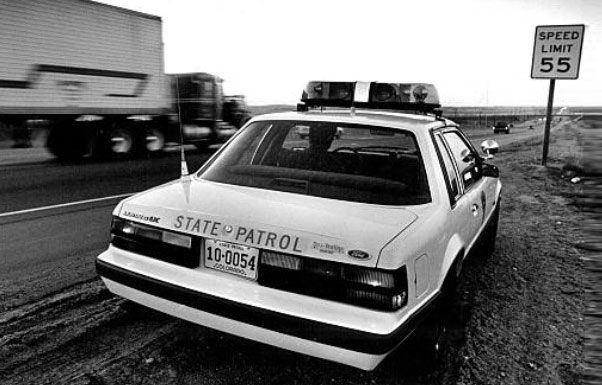 (Courtesy Jim Aitken)
(Courtesy Jim Aitken)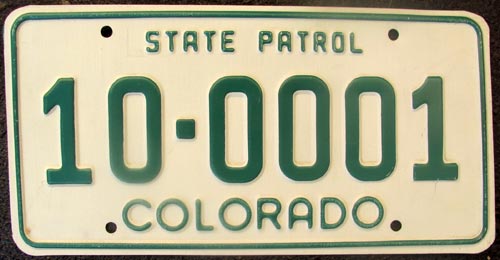 1983-1989 first issue- Embossed aluminum.
1983-1989 first issue- Embossed aluminum. 
 CSP Dodge Diplomat
CSP Dodge Diplomat 1983-1989 second issue. This version was made of embossed aluminum. Light green over non-reflective white. The light green raised characters were coated in a product called Flex-O-Lite. This coating was made-up of fine-crushed glass beads to take-on a reflective quality in low-light conditions. The surface paint and reflective material took a beating especially on the front of the vehicle when exposed to the elements over the course of time. The contrast between the light green and the white background was also not deep enough for contrast, so darker green was ordered for the third version.
(See plate #10-0212)
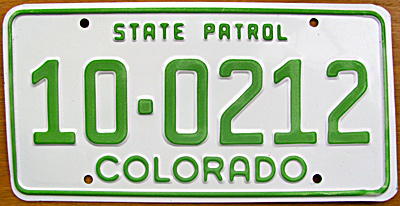 1983-1989 second issue-Embossed aluminum.
1983-1989 second issue-Embossed aluminum. 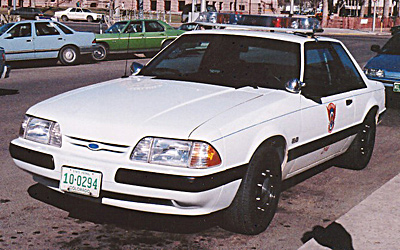 CSP SSP Mustang Number 294
CSP SSP Mustang Number 294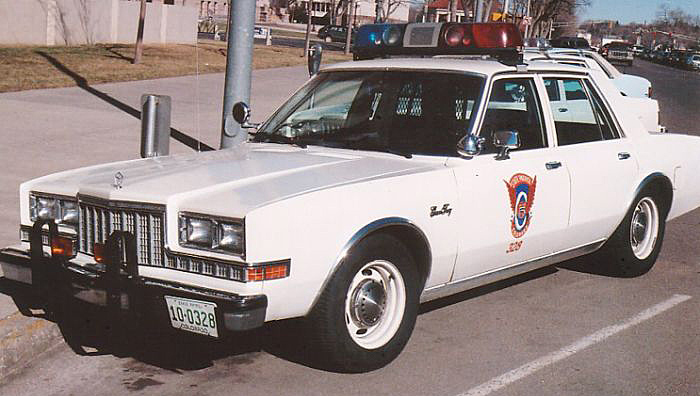
1983-1989 third issue. This version was also embossed aluminum. Dark green over non-reflective white. This darker green character version offered better contrast compared to the second issue, however the durability of the Flex-O-Lite coating was still not effective enough for a plate exposed to the extremes of Colorado weather and the "battle stresses" of patrol duty including car washes! (See plate #10-4073)
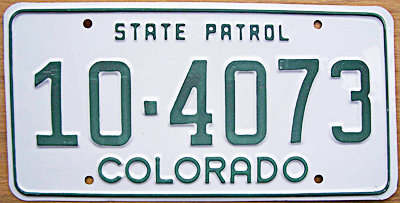 1983-1989 third issue-
1983-1989 third issue- 
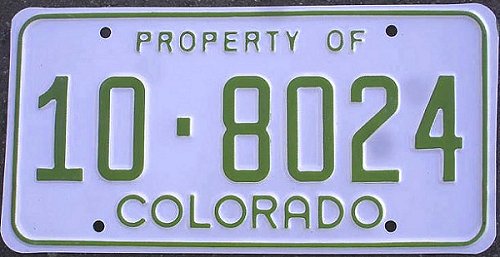 1983-1989 PROPERTY OF issue- Embossed aluminum.
1983-1989 PROPERTY OF issue- Embossed aluminum. 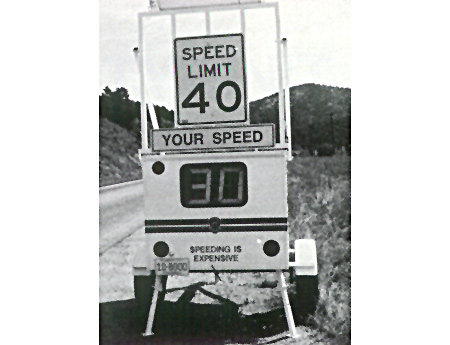
1989 to 1991 saw the introduction of bright and colorful aluminum plates introduced to the CSP known as the "Designer base". A screened mountain scene in blue over non-reflective white along the top legend of the plate with a stylized red and yellow "C" to the left of the state name over CSP-### over STATE PATROL embossed in small font dies along the bottom of the plate. The registration number and STATE PATROL were painted with blue Flex-o-Lite coating.(See plate #CSP-011)
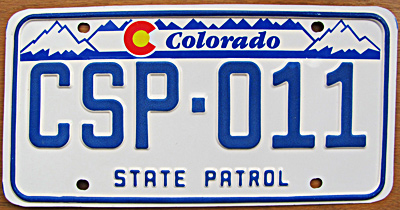 1989-1991 issue- Embossed aluminum.
1989-1991 issue- Embossed aluminum. 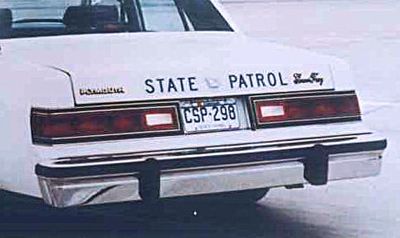 1989 CSP Plymouth Gran Fury # 298
1989 CSP Plymouth Gran Fury # 298
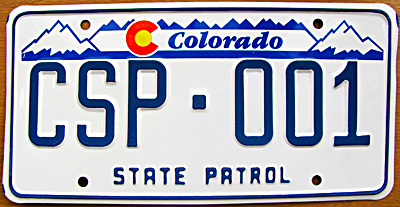 1989-1991 issue- Embossed aluminum. Dark blue over white. Thinner die type that did not go to full production. Assignment number for Colonel of CSP
1989-1991 issue- Embossed aluminum. Dark blue over white. Thinner die type that did not go to full production. Assignment number for Colonel of CSP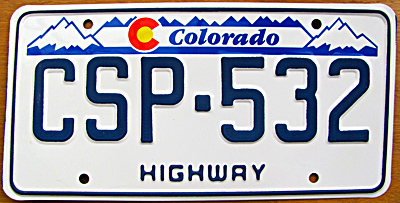 1989-1991 issue- Embossed aluminum. Dark blue over white. Error using the legend HIGHWAY instead of STATE PATROL
1989-1991 issue- Embossed aluminum. Dark blue over white. Error using the legend HIGHWAY instead of STATE PATROL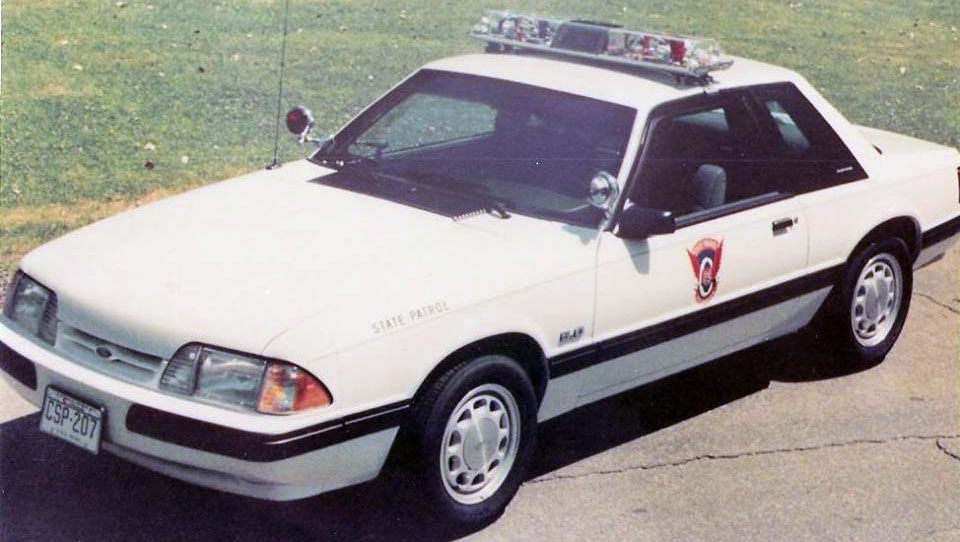
1991-1997: During this time frame, the 3M Company in Minnesota began to aggressively pursue the greater share of the Colorado license plate manufacturing market. The company provided these three different attractive versions of the same design free of charge to the State Patrol. This apparently was done unbeknownst to the Colorado Department of Motor Vehicles. Each version was dark blue over reflective white. They featured a step border and had the same top legend which was two dark blue horizontal stripes set against a light blue mountain range silhouette. The state name was placed between the top and bottom blue line with the red and yellow "C" to the left of it. COLORADO over CSP-### over STATE PATROL. The only embossing on the plate was the registration number. The first version has thicker dies on the characters and a long dash separating the CSP from the assignment number. (See plate #CSP-002)
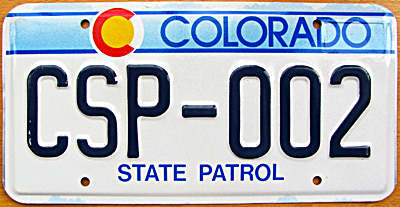 1991-1997 First issue-
1991-1997 First issue- 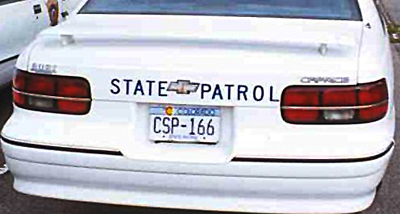 1991 CSP Chevrolet Caprice
1991 CSP Chevrolet Caprice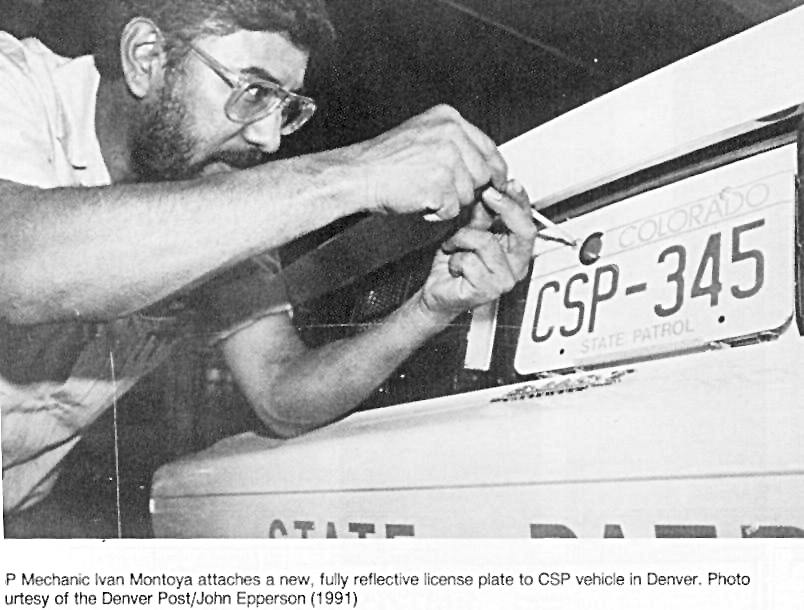
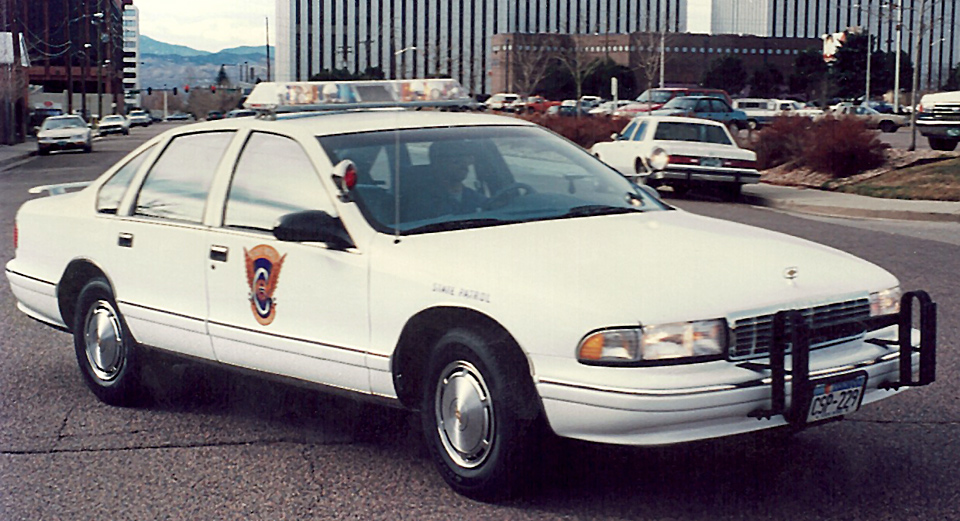
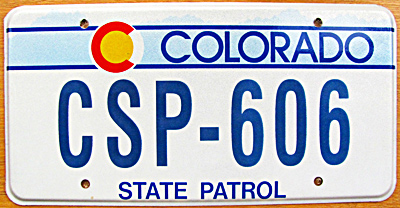 1991-1997 Second issue-
1991-1997 Second issue- 
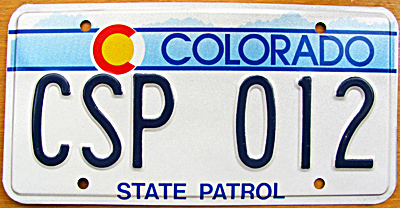 1991-1997 Third issue-
1991-1997 Third issue- 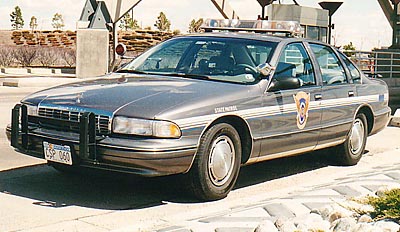 1996 CSP Chevrolet Caprice (CSP 060)
1996 CSP Chevrolet Caprice (CSP 060)1997-2008: 1997 saw the introduction of a radically redesigned license plate for the CSP motor vehicle fleet. Black over reflective white flat screened aluminum plates were issued with an embossed step border. The design featured a black silhouette mountain range along the top with the state name inside in white. COLORADO over CSP prefix followed by "Winged Wheel" CSP logo in full color ### STATE PATROL and a black band that runs the length of the plate along the bottom of the plate. Earlier versions include an inventory bar code in the lower right hand corner. Some of these plates also run validation decals. (See plate #CSP-536)
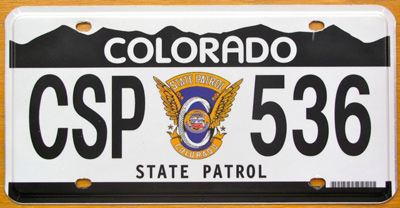 1997-2008 issue-
1997-2008 issue- 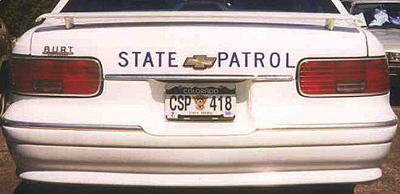 CSP 418 with validation decal in bottom right corner
CSP 418 with validation decal in bottom right corner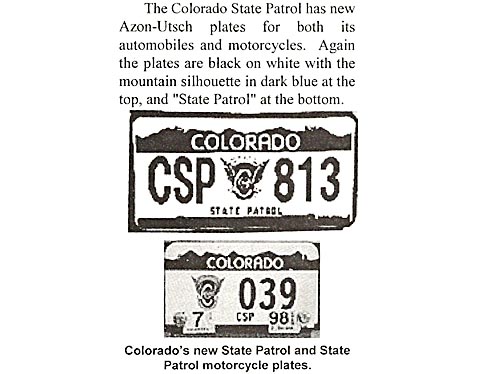
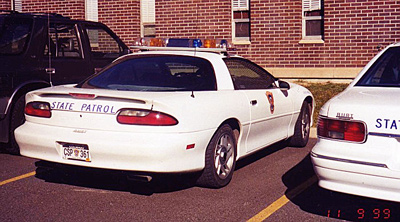 1998 CSP Chevrolet Camaro
1998 CSP Chevrolet Camaro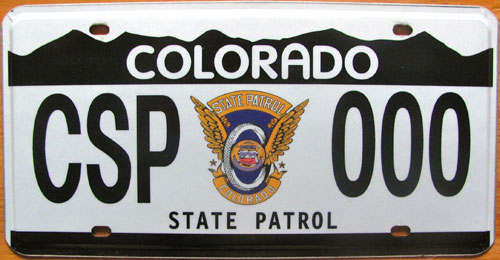 1997-2008 SAMPLE issue.
1997-2008 SAMPLE issue.
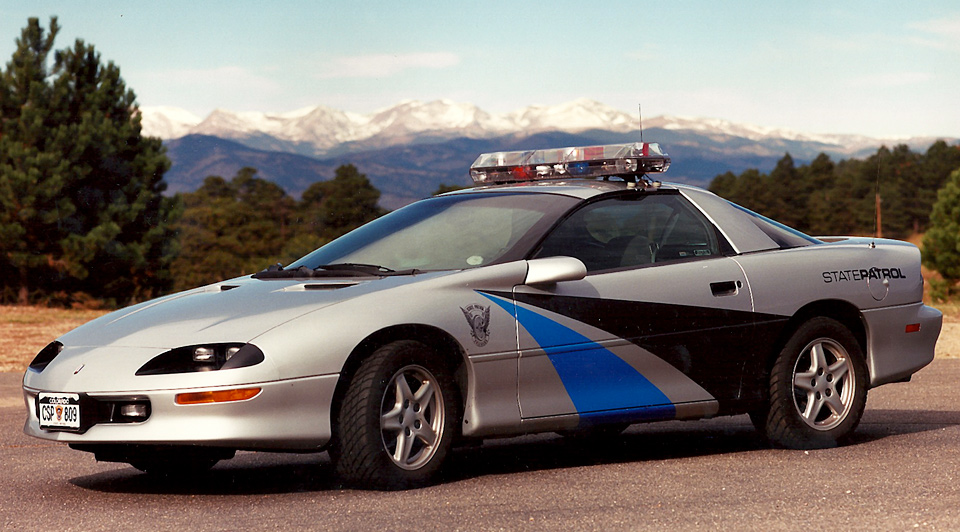
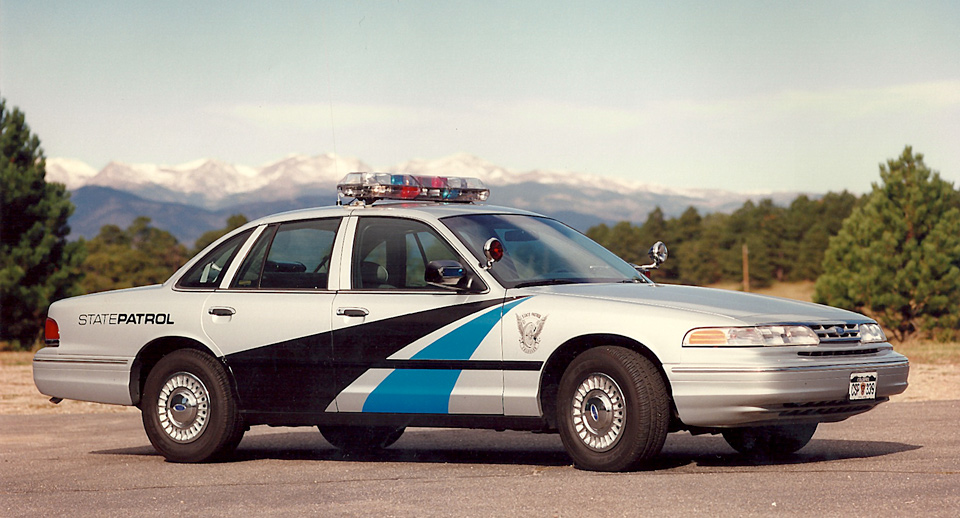
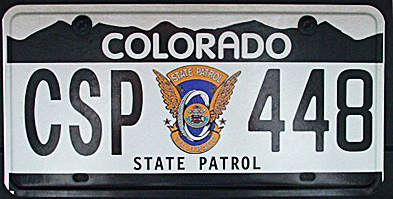 2008-Current issue-
2008-Current issue- 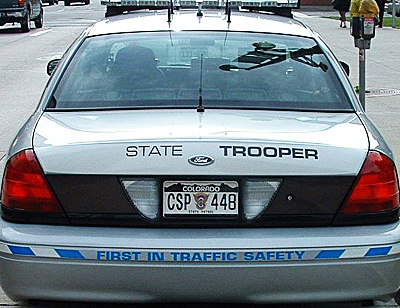
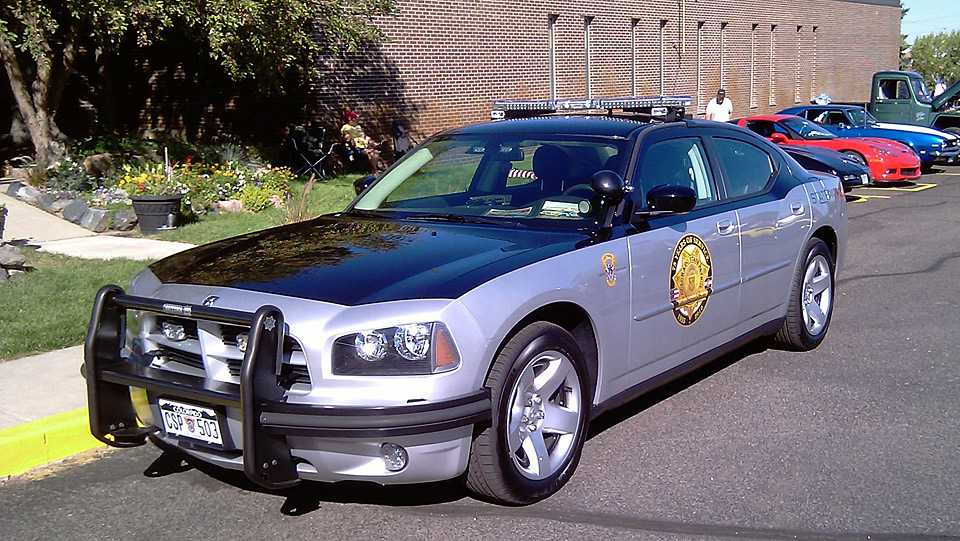
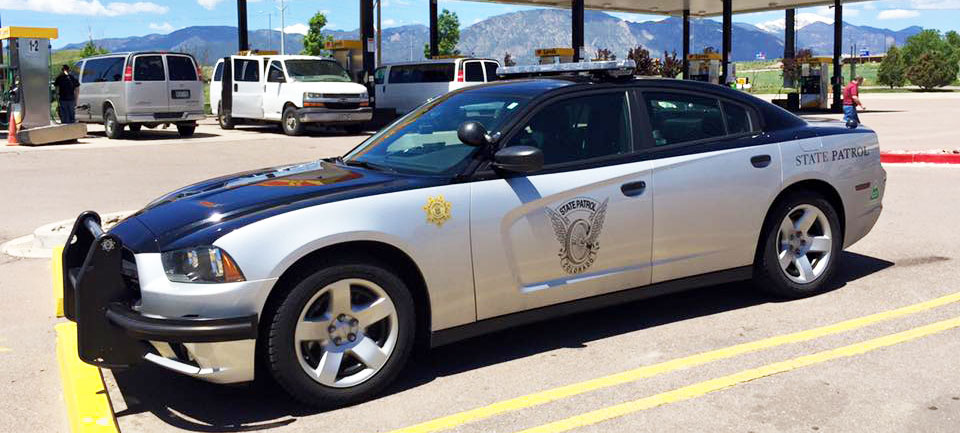
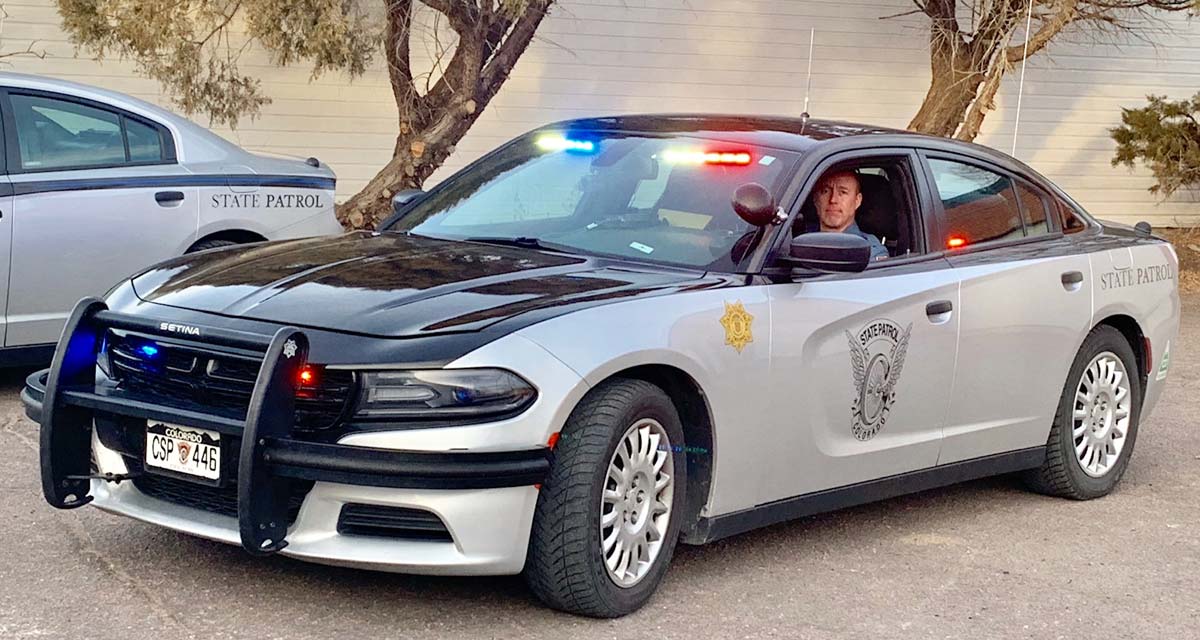
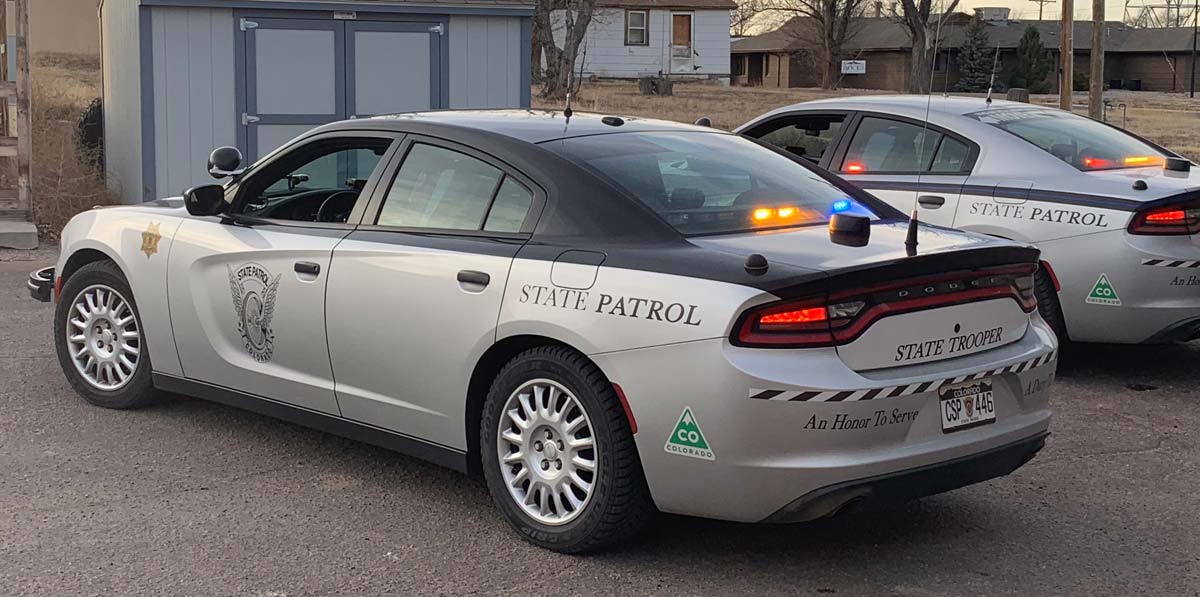
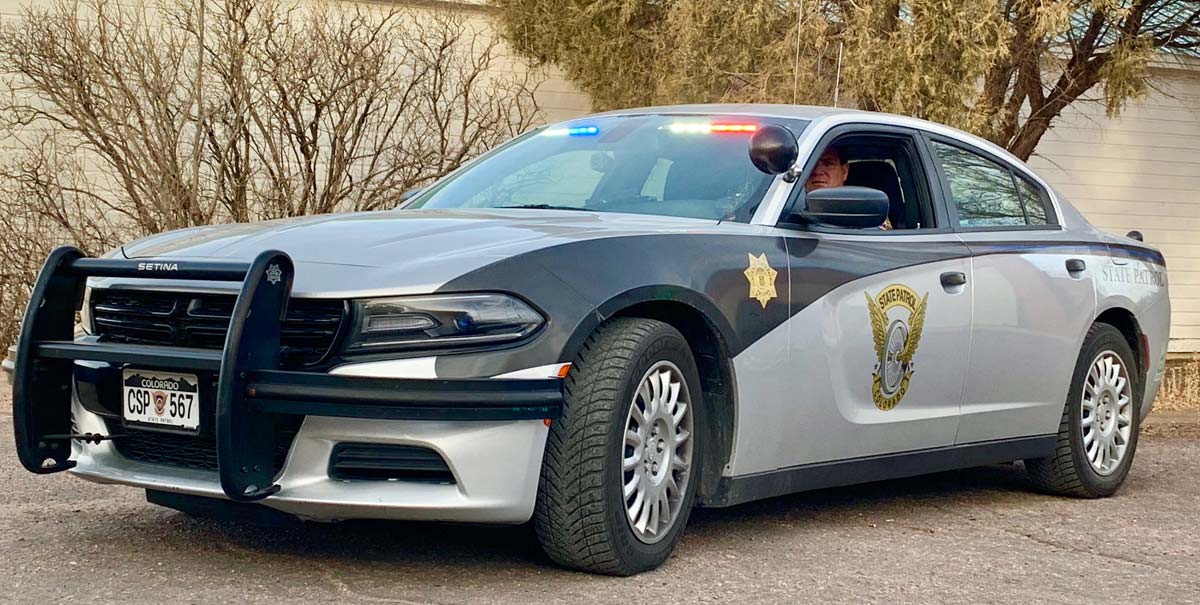
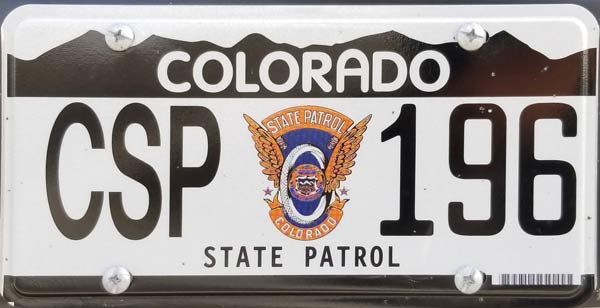 Circa 2019 issue with slight variance to CSP prefix and addition of bar code at bottom right corner.
Circa 2019 issue with slight variance to CSP prefix and addition of bar code at bottom right corner.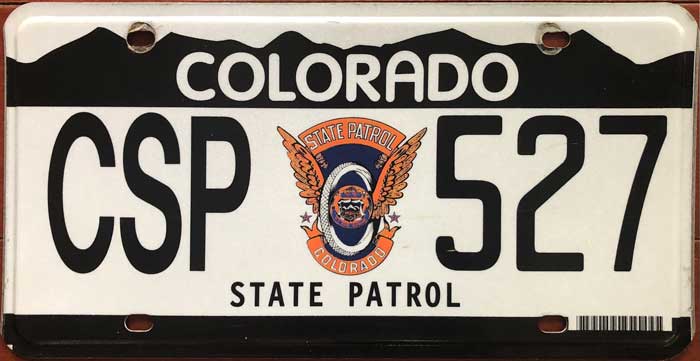 2021. Using bar code.
2021. Using bar code.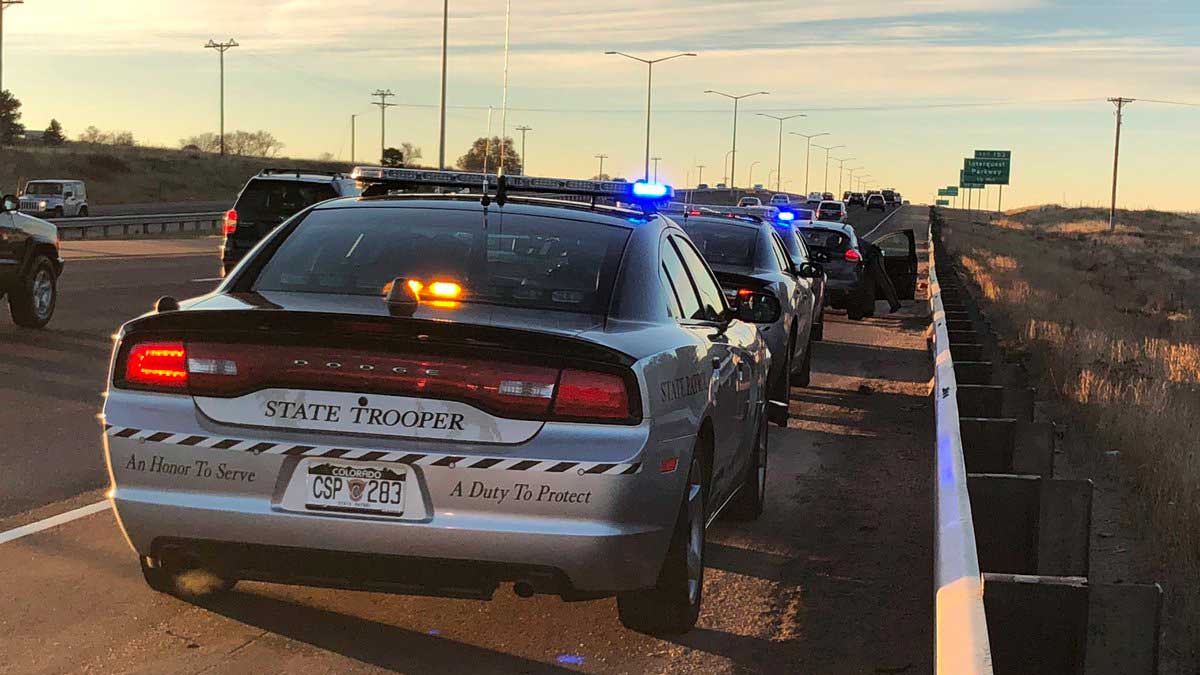 2022
2022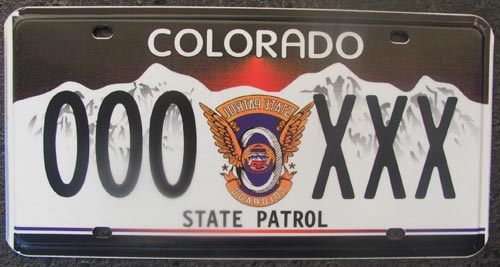 Circa 2015 prototype error plate.
Circa 2015 prototype error plate.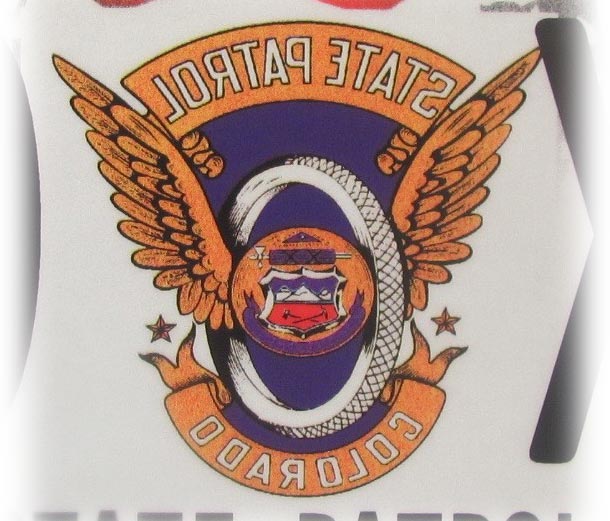
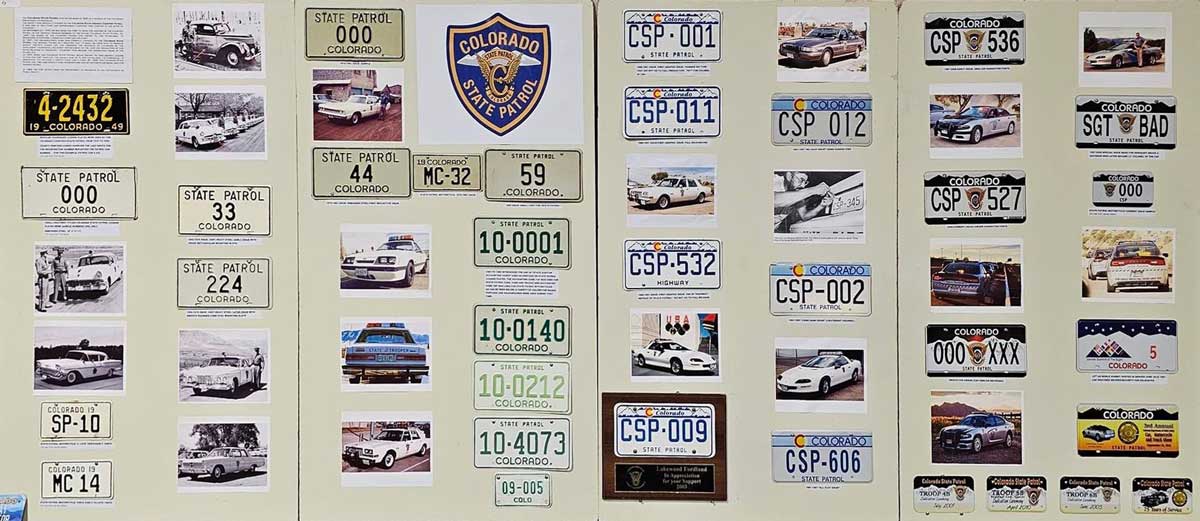 Complete display of Colorado State Patrol license plates (1949-Current) Assembled and displayed by Norm Ratcliffe at the 68th International ALPCA Convention held in Denver Colorado- July 2023. Won CONVENTION AWARD for Best Host State Display.
Complete display of Colorado State Patrol license plates (1949-Current) Assembled and displayed by Norm Ratcliffe at the 68th International ALPCA Convention held in Denver Colorado- July 2023. Won CONVENTION AWARD for Best Host State Display. The earliest known motorcycle license plate for the CSP was from 1954, and was embossed steel. It measured 8" x 4" and was black over white. It had an embossed painted border with STATE PATROL embossed along the top over a number up to 2 digits. One mounting hole in each corner of the plate. No state name. Unknown how long it was used for.
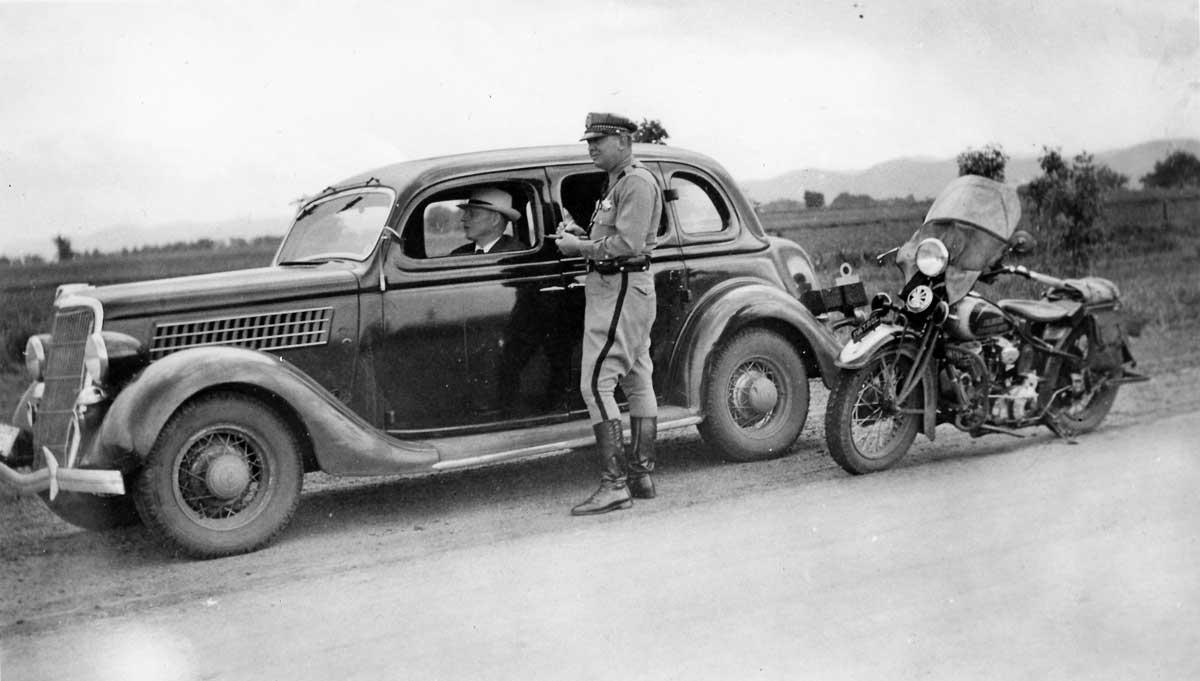 Circa 1938
Circa 1938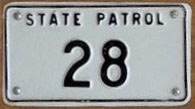 1954 motorcycle issue- Embossed steel.
1954 motorcycle issue- Embossed steel. 
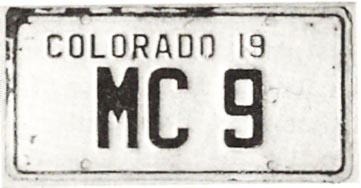 1960's motorcycle issue-
1960's motorcycle issue-
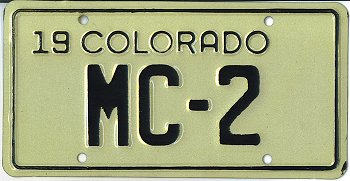 1970-1983 motorcycle issue-
1970-1983 motorcycle issue- 
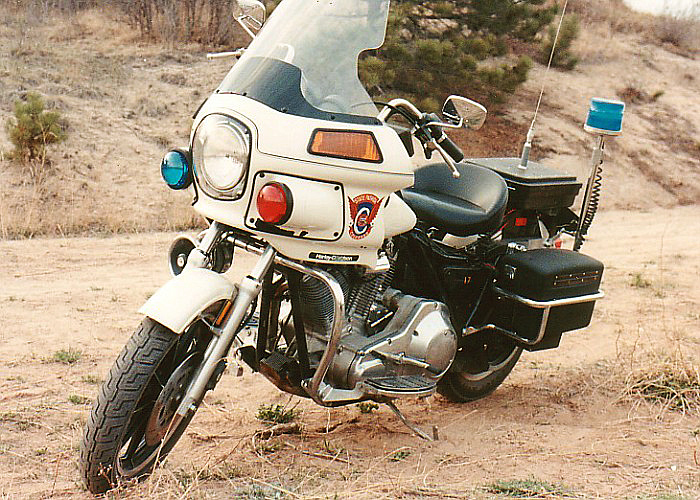
1983-1985 and 1988-Circa 1996: An embossed aluminum plate measuring 7" x 4" was issued during this time. It was green over non-reflective white. The plate consisted of a number beginning with 09-### over COLORADO. The prefix number 09 was the Colorado State Auditor's accounting code number for CSP motorcycles.
The CSP had ceased using motorcycles in January of 1985 and sold-off the fleet. The 1983-issue motorcycle plates were placed in storage after removal from the decommissioned cycles. In 1988, eight new Harley Davidson motorcycles were purchased by the CSP. The 1983 "09$" license plates which had been removed and placed in storage in 1985 were re-assigned to the new fleet. It is believed that these plates were used on CSP motorcycles until the mid 1990's. (See plate #09-005)
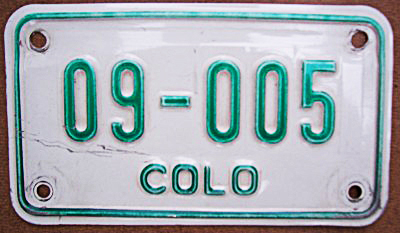 1983-Circa 1996 motorcycle issue- Embossed aluminum.
1983-Circa 1996 motorcycle issue- Embossed aluminum.
 1997-Current motorcycle issue- All-flat screened aluminum.
1997-Current motorcycle issue- All-flat screened aluminum. 
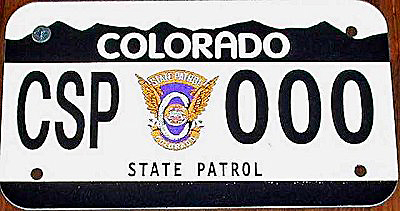 1997-current motorcycle issue.
1997-current motorcycle issue. 
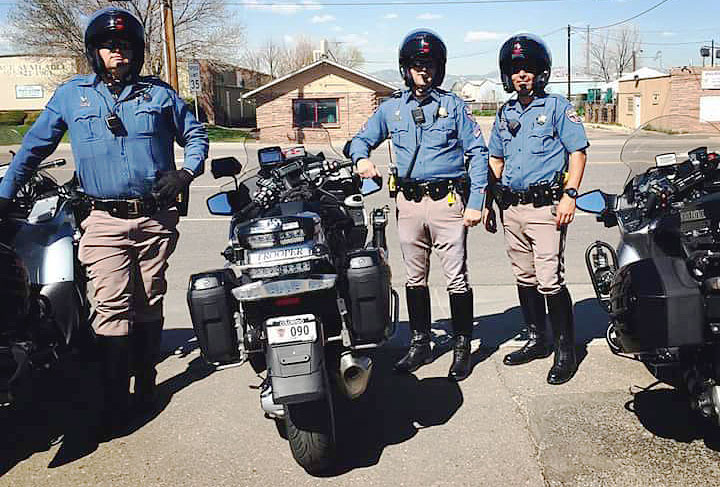 (Courtesy Tony Aleria)
(Courtesy Tony Aleria)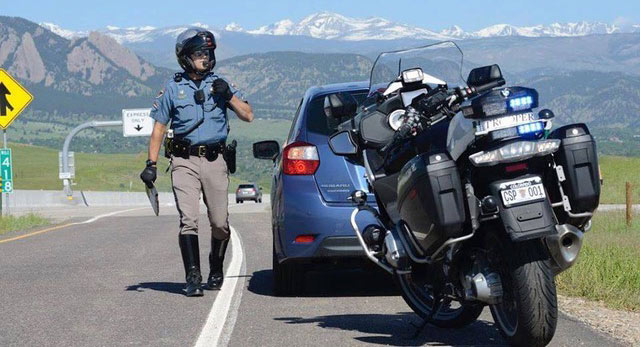 (Courtesy Tony Aleria)
(Courtesy Tony Aleria)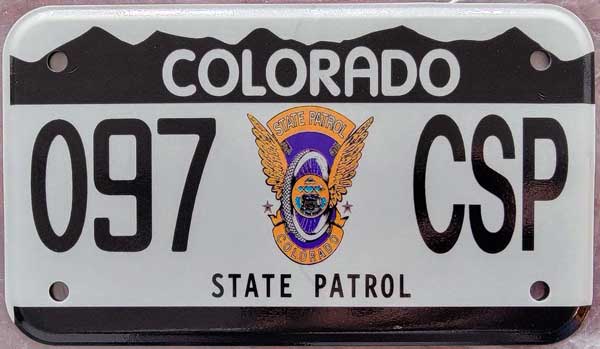 Circa 2021-Current issue.
Circa 2021-Current issue.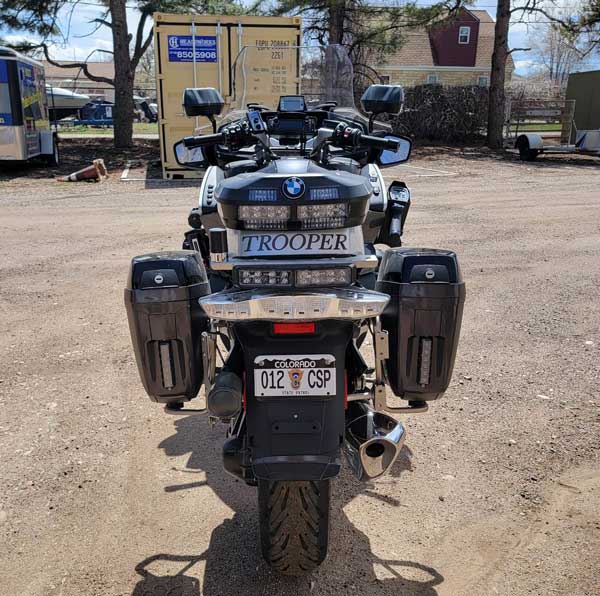 (Courtesy Tony Aleria)
(Courtesy Tony Aleria) In addition to regular patrol vehicle and motorcycle license plates used by the CSP, there is also what is known as an "In Transit" plate. This type would be used on a CSP vehicle that had not yet been officially registered but needed to be moved from one locale (usually the CSP garage) to another whether under its own power or while being towed. Confirmed # 4 seen in photograph, but unsure if "IN TRANSIT" plates are still used by CSP today.
The CSP is the only state policing agency in the USA known to use titled "In Transit" license plates.
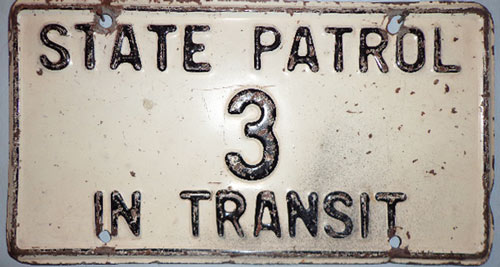 Pre-1970 IN TRANSIT issue-
Pre-1970 IN TRANSIT issue-  1970-1983 IN TRANSIT issue- Embossed steel.
1970-1983 IN TRANSIT issue- Embossed steel. 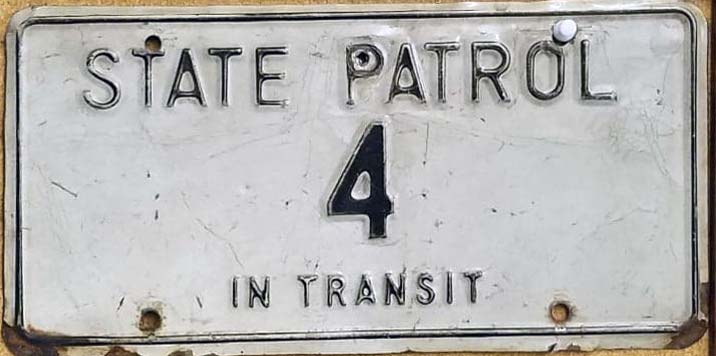
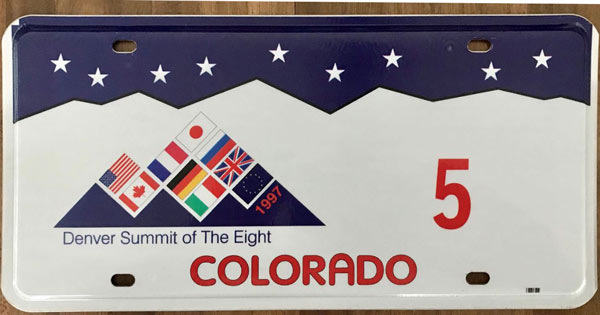 1997 G8 Economic Summit issue. Screened aluminum.
1997 G8 Economic Summit issue. Screened aluminum.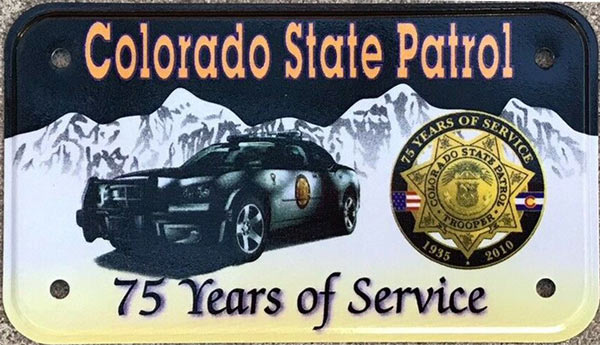 2010 75th Anniversary souvenir plate.
2010 75th Anniversary souvenir plate.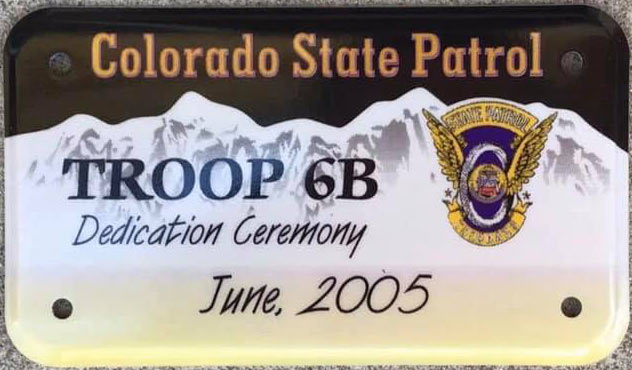 2005 Troop 6B Dedication Ceremony
2005 Troop 6B Dedication Ceremony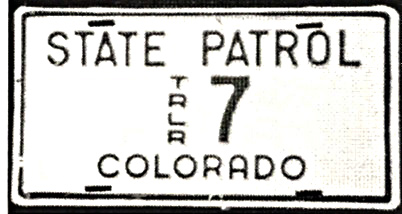 1955-1970 trailer issue-
1955-1970 trailer issue- 
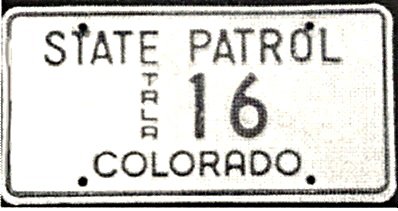 1970-1983 trailer issue- Embossed galvanized steel.
1970-1983 trailer issue- Embossed galvanized steel. 
1989 to 1991: "Designer Base" trailer plates: A screened mountain scene in blue over flat white along the top legend of the plate with red and yellow "C" to the left of the state name. Colorado over CSP-T## over STATE PATROL embossed in small font dies along the bottom of the plate. The registration number and STATE PATROL were painted with blue Flex-o-Lite. Since so few trailers are used by the CSP, it can be surmised that this type may still be in use today.
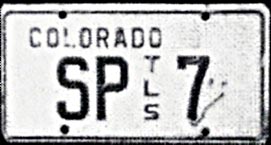 Circa 1960's Small Trailer issue- Embossed steel.
Circa 1960's Small Trailer issue- Embossed steel. 